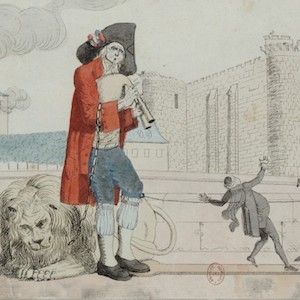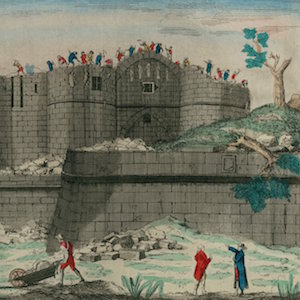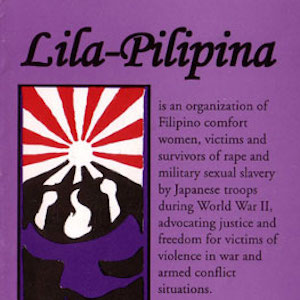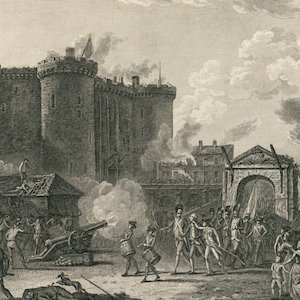Politics

The Day of 21 July 1789
More common than clashes by workers against employers were protests over the rising price of bread. This color drawing depicts events at the City Hall of Strasbourg on 21 July 1789.

Farewell Bastille
This hand–colored engraving equates the taking of the Bastille with the rise of the Third Estate against the clergy and nobility. A commoner in a black hat sporting a tricolor cockade plays the bagpipe triumphantly over the fallen lion of the absolutist monarchy.

Demolition of the Bastille
This watercolor painting illustrates the "demolition" of what the text refers to as the "horrible prison" of the Bastille. As workmen tear down the spires on the roof, ordinary people rip stones off the base.

Punishment of Foulon
This engraving reveals the aftermath of the seizure of the Bastille. Here the crowd parades the severed head of the official, Foulon.

Attack on the Bastille
This engraving of the attack highlights the heroism of the people charging determinedly into the billowing clouds and firing relentlessly in the face of strong resistance emanating from the fortress.

Sugarcane Workers Strike
After the United States's occupation of Puerto Rico in 1898, agricultural production shifted from a diverse model of production to a mono-agricultural model of growth, where sugar was the main crop.

Woman with Lenin/Stalin Flag
Articles and images published in Soviet newspapers on March 8, International Communist Woman’s Day, provide the most obvious examples of how women were used as symbols in a propaganda campaign.

Lila-Pilipina Brochure
The Lila-Pilipina Brochure is a creation of the feminist group of Filipino “comfort women" called Lila-Pilipina, who have banded together with feminist goals/messages for peace.

Taking of the Bastille
The "bravery of the citizens united against" the royal army, as the text suggests, enabled them to conquer in four hours a fortress that had defeated invasions since 1368.

Taking of the Bastille
This painting emphasizes the populace’s participation in the storming of the Bastille, showing the urban population fighting under a red banner with muskets, swords, and pikes against the royal soldiers.